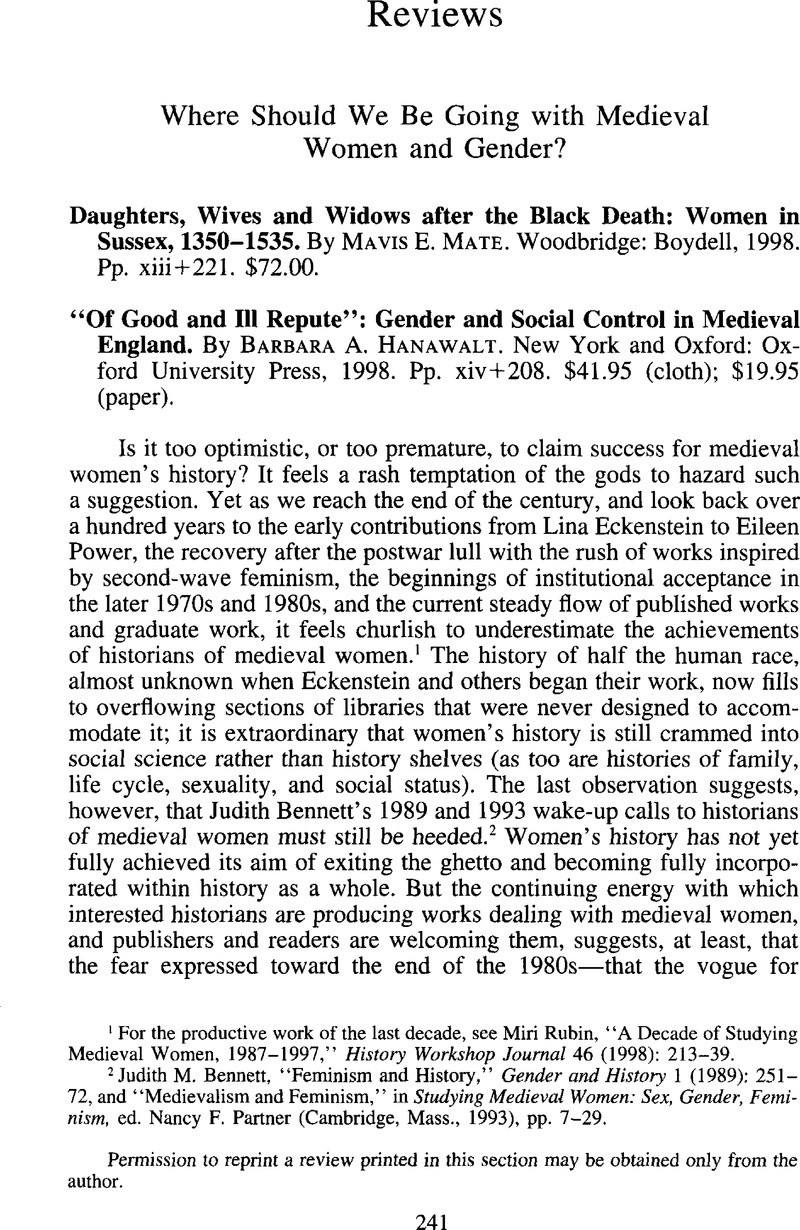No CrossRef data available.
Article contents
Where Should We Be Going with Medieval Women and Gender? - Daughters, Wives and Widows after the Black Death: Women in Sussex, 1350–1535. By Mavis E. Mate. Woodbridge: Boydell, 1998. Pp. xiii + 221. $72.00. - “Of Good and Ill Repute”: Gender and Social Control in Medieval England. By Barbara A. Hanawalt. New York and Oxford: Oxford University Press, 1998. Pp. xiv + 208. $41.95 (cloth); $19.95 (paper).
Review products
Published online by Cambridge University Press: 10 January 2014
Abstract

- Type
- Reviews
- Information
- Copyright
- Copyright © North American Conference of British Studies 2000
References
1 For the productive work of the last decade, see Rubin, Miri, “A Decade of Studying Medieval Women, 1987–1997,” History Workshop Journal 46 (1998): 213–39Google Scholar.
2 Bennett, Judith M., “Feminism and History,” Gender and History 1 (1989): 251–72CrossRefGoogle Scholar, and “Medievalism and Feminism,” in Studying Medieval Women: Sex, Gender, Feminism, ed. Partner, Nancy F. (Cambridge, Mass., 1993), pp. 7–29Google Scholar.
3 Bennett, , “Feminism and History,” p. 258Google Scholar. For other voices of opposition, see Shoemaker, Robert and Vincent, Mary, eds., Gender and History in Western Europe (London, 1998), pp. 7–8Google Scholar.
4 Riley, Denise, “Am I That Name?” Feminism and the Category of “Women” in History (Houndmills, 1988)Google Scholar; Butler, Judith, Gender Trouble: Feminism and the Subversion of Identity (New York, 1990)Google Scholar, and Bodies That Matter: On the Discursive Limits of “Sex” (New York, 1993)Google Scholar.
5 Most medievalists would dispute the Laqueur thesis of pre-Enlightenment “real gender” and “epiphenomenal sex” (Laqueur, Thomas, Making Sex: Body and Gender from the Greeks to Freud [Cambridge, Mass., 1990])Google Scholar. See rather Cadden, Joan, Meanings of Sex Difference in the Middle Ages: Medicine, Science, and Culture (Cambridge, 1993)Google Scholar.
6 Goldberg, P. J. P., Women, Work, and Life Cycle in a Medieval Economy: Women in York and Yorkshire c. 1300–1520 (Oxford, 1992)CrossRefGoogle Scholar; Barron, Caroline M., “The ‘Golden Age’ of Women in Medieval London,” Reading Medieval Studies 15 (1989): 35–58Google Scholar; Bennett, Judith M., “Medieval Women, Modern Women: Across the Great Divide,” in Culture and History, 1350–1600: Essays on English Communities, Identities and Writing, ed. Aers, David (London, 1992), pp. 147–75Google Scholar, and Ale, Beer and Brewsters in England: Women's Work in a Changing World (New York and Oxford, 1996)Google Scholar.
7 Goldberg, , Women, Work, and Life Cycle, pp. 205–32Google Scholar.
8 Hanawalt, Barbara A., The Ties That Bound: Peasant Families in Medieval England (New York and Oxford, 1986)Google Scholar.


